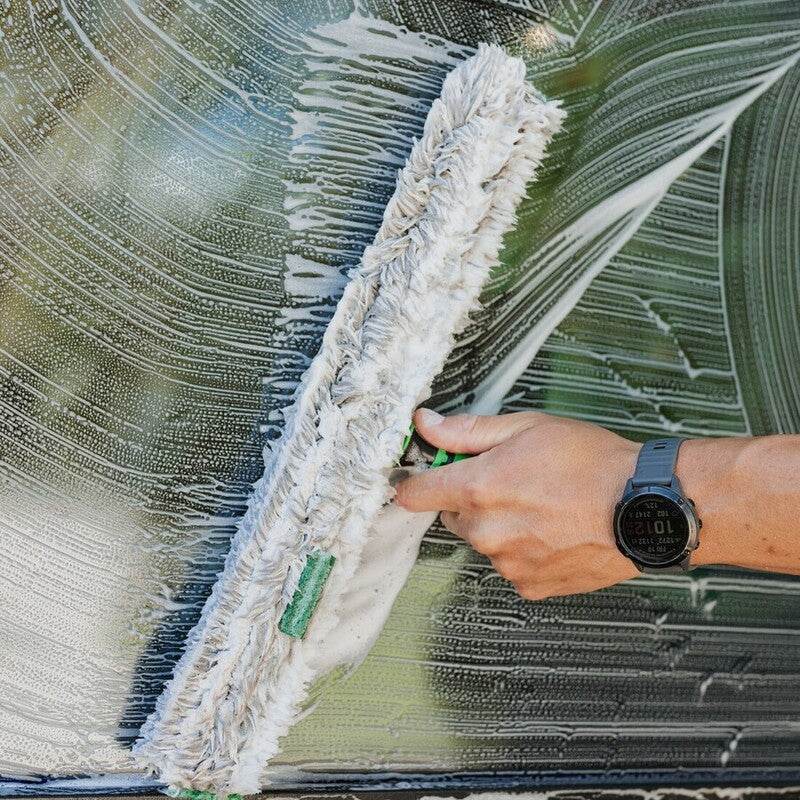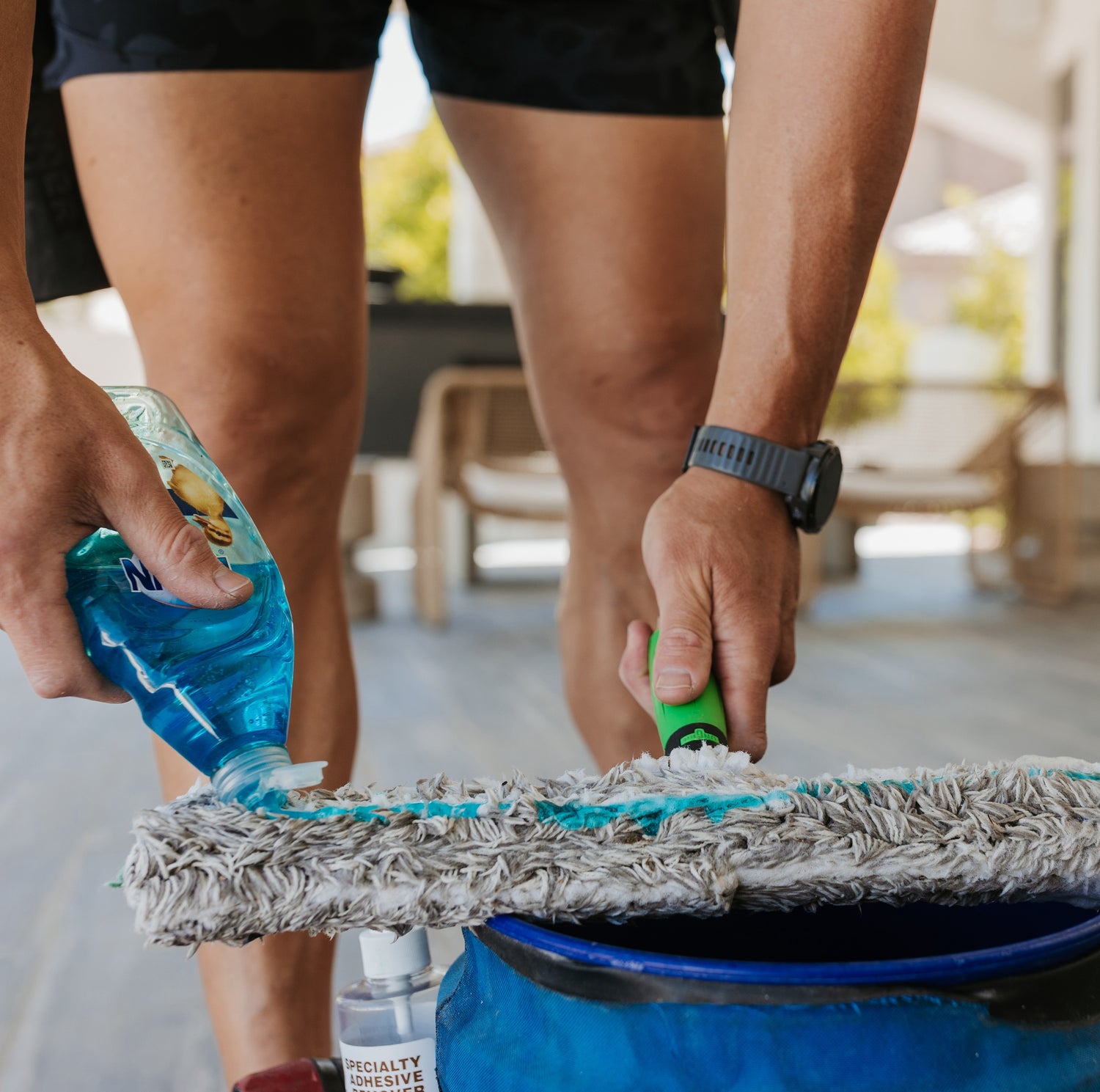YEAREND
Scrubber Sleeves
 FREE SHIPPING ON ORDERS OVER $49
FREE SHIPPING ON ORDERS OVER $49
*Ground shipments to the continental US.

What is a scrubber sleeve?
A window cleaning scrubber sleeve is a reusable, absorbent fabric material that attaches to a T-Bar to brush glass and apply cleaning solution. This piece of equipment is best friends with your window cleaning T-Bar and together, they prepare a window for the squeegee through lubrication and agitation. A scrubber sleeve is the keystone in window preparation and will always be among your tools when cleaning traditionally. Without a good sleeve, your glass surface will be dry and rough, a squeegee's worst nightmare. A scrubber sleeve is usually attached to a T-bar by sliding over the long cylindrical segment and secured with an elastic loop inside followed by velcro at the outer seams. Together the loop and velcro minimizes movement against the T-Bar so your scrubbing efforts are efficiently applied to the glass.
Scrubber sleeves come in a wide range of sizes to match the length of your T-Bar. They also come in many different materials varying in levels of abrasiveness, absorbency, color, and durability. Regardless, a scrubbing sleeve is going to set the stage for your squeegee to finish up the job so it’s important to find something that suits your preferences.

What types of scrubber sleeves are there?
Scrubber sleeves come in an array of colors, sizes, and materials. From 6” to 24” there’s a sleeve for every window size. You can even pick your favorite color! But what really sets them apart from one another is their level of abrasiveness and absorptivity. Abrasiveness can be thought of as its scrubbing power or ability to remove stubborn stains. A more abrasive sleeve will be much appreciated when you run into glass with mineral residue or sticky fingerprints for example. It will have enough scrubbing power to break down stubborn debris without scratching the surface. On the other hand, a soft microfiber sleeve will be very gentle on the glass and be fantastic for delicate surfaces like a tinted window. Fortunately, some sleeves will have the best of both worlds such as the Pulex MicroTiger, featuring alternating strips of microfiber and abrasive material so you can do it all at once! A more absorbent sleeve is going to hold a larger volume of fluid allowing you to cover more surface area before going back to your bucket or sprayer, saving you precious time and energy. This is also advantageous when tackling those hot panes of glass in direct sunlight that keep drying on you quickly! On the other hand, you might be working inside and prefer a less absorptive sleeve to minimize drip and extra detailing from excess solution runoff.
After finding a sleeve with the cleaning properties you desire, it’s time to pick a size! Similar to squeegees, scrubbers are going to come in a range of lengths for you to choose from depending on window size and your cleaning style. A smaller sleeve will feel more maneuverable but may be inefficient on larger panes. Whatever your choice is, don’t forget to get a T-Bar of the same size to pair with your new sleeve!

Which scrubber sleeve should I get?
The right scrubber sleeve for you will greatly depend on the type of windows you’ll be cleaning, your personal preferences, and your cleaning style. This means the simple answer is to have many sleeves so you’re always prepared. But the question remains, how do you know what scrubber you should use? Consider the following questions; How big are the windows? Are your windows caked in dirt and grimy fingerprints? Or, do your windows have fragile tint film with a light layer of dust? Are you doing commercial storefronts or residential homes? These are all key considerations when trying to choose a sleeve. At the end of the day, a professional will have a variety of sleeves to pick and choose from depending on the situation.
A 24” scrubber isn’t going to work on French panes, and a 6” mop isn’t going to be a wise choice for a large sliding glass door. Pick a scrubber size that will cover a good amount of surface area while preserving your ability to scrub in multiple directions. The right size sleeve will help you be more efficient. Consider a sleeve on the larger size when cleaning big pieces of glass to minimize excess scrubbing and time waste. For extra dirty glass and jobs where speed is a priority, a more abrasive sleeve might be the best choice. The ability to cut through tough grime will reduce the scrubbing time on each window and prevent fatigue. When doing routine maintenance or working with a more delicate surface, consider using a soft microfiber sleeve. You might even find the less abrasive materials like the plush microfibers tend to hold more water!
In the end, the different kinds of materials with varying degrees of scrubbing and absorptive abilities will shape the user experience. Maybe you like the way one sleeve slides on glass or the way it fits into your Boab. With that being said, your unique preferences will ultimately guide your decision on what sleeve is best for you. To get a good taste for the options available, check out the Scrubber Sleeve Value Pack.

Why is aggressive scrubbing power important?
Aggressive scrubbing power is important because it allows you to cut through tough grime with less effort and less time invested. And since “time is money”, this is a very valuable advantage to have. Every window cleaner knows how frustrating it is to scrub then squeegee a window only to find debris remnants lingering on the glass. Rather than chasing your tail on the job, you can ensure it’s done right the first time by deploying your most abrasive scrubber right off the bat. Depending on how dirty your glass is, you might even be able to get two birds with one stone by completely eliminating additional steps such as scrubbing with steel wool. With all this saved time you can schedule more clients or even just sit back and relax! Either way, you’re also going to reduce wear and tear on your body and preserve energy. This may allow you to perform more services in a day and ultimately extend the longevity of your career. At the end of the day, aggressive scrubbing power is a resource that will greatly open up your options and problem-solving capabilities.

What is proper care for sleeves?
Proper sleeve care involves routine cleaning to prolong functionality, eliminate odors, and maintain color. One of the simplest methods for cleaning sleeves is to toss them into the laundry machine with your detailing rags. Ideally, you’ll be using a free and clear detergent with no fabric softeners to minimize residue buildup on your equipment. Let your sleeves air dry rather than using a drying machine as the high heats may accelerate fabric degradation and cause shrinking. This cleaning method is quite thorough so it will help restore the original color of your sleeve and get rid of any foul smells while preserving the stitches, absorptivity, and abrasive qualities. For very dirty jobs that leave your mop caked in grime, it might be a good idea to do ‘quick washes’ throughout the service by removing your sleeve from the T-bar so you can rinse and ring it several times. This can help prolong usability until your next machine wash but most importantly, it will flush out any debris stuck in the fibers that could potentially scratch glass. A quick wash like this is also great when you drop your T-bar and mop onto a dirty surface. When it comes to storage, avoid leaving your sleeves soaked in harsh chemicals or in direct sunlight. These conditions can be harmful to the material and will potentially shorten the lifespan of your equipment.

